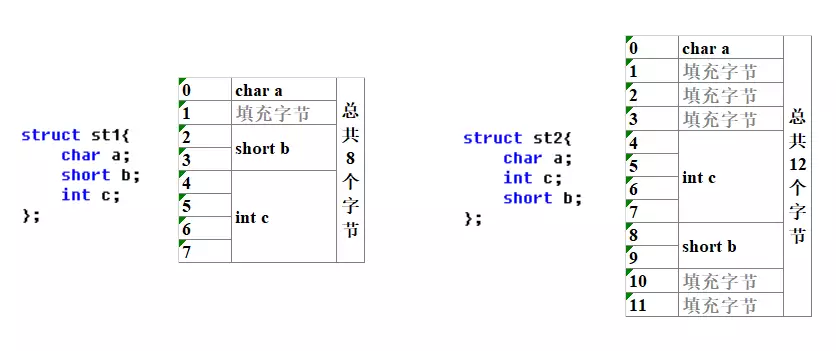C | 結構體位元組對齊
2023-03-19 12:00:56
01.位元組對齊現象
#include<stdio.h>
struct st1{
char a;
short b;
int c;
};
struct st2{
char a;
int c;
short b;
};
int main(){
printf("sizeof st1 = %u\n", sizeof(struct st1));
printf("sizeof st2 = %u\n", sizeof(struct st2));
return 0;
}
輸出:
sizeof st1 = 8
sizeof st2 = 12
st1和st2的成員變數均為一個char變數、一個int變數、一個short變數,區別在於二者的成員變數順序不同。
但是st1和st2兩結構體所佔記憶體大小卻不一致,這一奇怪的現象底層就是因為C語言結構體發生了位元組對齊。
02.為什麼要位元組對齊——以空間換時間
記憶體的最小單元是一個位元組,理論上當cpu從記憶體中讀取資料時,應該是逐位元組讀取。但是實際上cpu將記憶體當成了多個塊,這個塊的大小可能是2、4、8、16等。位元組對齊是作業系統為了提高記憶體存取效率的策略。如果沒有對齊,就會有可能出現為了存取一個變數卻進行了多次記憶體存取的情形。
2.1 位元組對齊原理
1)變數地址規則
#include<stdio.h>
int main(){
char c1, c2, c3;
short s1, s2, s3;
int i1, i2, i3;
double d1, d2, d3;
printf("char:\t%lld %lld %lld\n", &c1, &c2, &c3);
printf("short:\t%lld %lld %lld\n", &s1, &s2, &s3);
printf("int:\t%lld %lld %lld\n", &i1, &i2, &i3);
printf("double:\t%lld %lld %lld\n", &d1, &d2, &d3);
return 0;
}
輸出:
char: 1703724 1703720 1703716
short: 1703712 1703708 1703704
int: 1703700 1703696 1703692
double: 1703684 1703676 1703668
發現現象:
同一型別下,其每個變數的地址一定可以被該型別所佔記憶體大小(位元組為單位)整除。如(64位元作業系統下):
- char中的1703724 、1703720 、1703716均能被1整除(char佔1個位元組);
- short中的1703712 、1703708 、1703704均能被2整除(short佔2個位元組);
- int中的1703700 、1703696 、1703692均能被4整除(int佔4個位元組);
- double中的1703684 、1703676 、1703668均能被8整除(double佔8個位元組)。
2)結構體位元組對齊
-
結構體中每個成員變數,其變數地址須滿足該地址能夠被該型別所佔記憶體大小(位元組為單位)整除(即地址是該型別長度的整數倍),如不滿足,則填充位元組直至當前地址滿足此條件。
-
結構體的總大小須為其最大成員大小的整數倍,如不滿足,最後填充位元組以滿足。

理解請參考:
03.結構體巢狀結構體進行位元組對齊
#include<stdio.h>
#include<stdlib.h>
#include<string.h>
struct sa{
int a; //0-3
char b; //4
double c; //8-15
};
struct sb{
char a; //0
struct sa b; //8-23
double c; // 24-31
};
int main(){
printf("sizeof(struct sa):%u\n", sizeof(struct sa));
printf("sizeof(struct sb):%u\n", sizeof(struct sb));
return 0;
}
輸出:
sizeof(struct sa):16
sizeof(struct sb):32
注意:
struct sb中的欄位b,是以其內部的最大變數型別位基準(即double),而不是以sturct sa結構體的大小位基準。